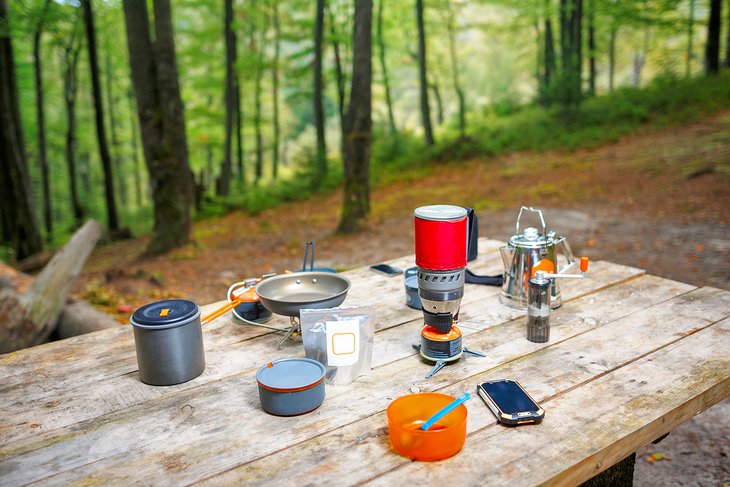There’s nothing quite like embarking on a camping trip, leaving the hustle and bustle of everyday life behind, and reconnecting with nature. But before you can fully immerse yourself in the wonders of the wilderness, one essential task often stands in the way. This task is the process of organizing your camping gear. Don’t let the thought of tangled tent poles and missing marshmallow skewers dampen your spirit.
In this article, we’ll guide you through the art of organizing your camping gear so that you can ensure your next outdoor excursion is as seamless and stress-free as possible.
Tips For Organizing Your Camping Gear
-
Clean the equipment and remove any mold
Maintaining cleanliness and hygiene in your camping gear is essential for both functionality and comfort. Before storing your equipment, ensure to clean it thoroughly. Wipe away any mold, bacteria, or unpleasant odors that may have accumulated.
You can begin by removing caked-on mud using a soft-bristled brush and spot cleaning with a damp sponge. In most cases, water and a little elbow grease should suffice for cleaning your camping gear. However, you can use natural cleansers specifically designed for such purposes if necessary.
It’s important to avoid using chemical detergents like bleach or all-purpose cleaners, as they can cause damage to the surfaces of your equipment. Go for gentler alternatives to ensure the longevity of your gear.
While cleaning, pay close attention to any signs of mold or bacteria. Failure to address these issues can lead to further growth and potential infestations. Vinegar, specifically white distilled vinegar with 5 to 6% acidity, is an effective natural solution for removing mold. Simply apply the vinegar directly to the affected areas for optimal results.
-
Ensure the gear is dry before packing
One essential step in organizing your gear is ensuring everything is dry before packing. Neglecting this can lead to unpleasant consequences, such as mold, odors, and even the need to replace items prematurely.
When you allow your gear to get dry before packing, you can easily prevent the development of mildew and the accumulation of unwanted odors.
To ensure thorough drying, clean your gear first and let it air dry for at least three hours. You can also sundry the gears for added effectiveness for a day or two. The sun’s natural disinfectant properties will help eliminate mold and spores while keeping your equipment fresh and free from musty odors.
Additionally, consider placing dryer sheets alongside your tents, sleeping bag, and backpacks when storing them. These sheets will absorb any lingering smells, leaving your gear smelling pleasant and ready for your next adventure.
-
Organize and categorize the gear
Organizing and categorizing your camping gear is essential for easy access and a stress-free camping experience. Instead of roughly storing your equipment, consider the following tips to streamline your gear organization.
Invest in plastic bins, heavy-duty totes, or hanging shoe organizers to store your gear. Label each container to save time when searching for specific items, preventing hours of rummaging.
Begin by laying out your gear and separating them into piles based on their purpose. Identify items no longer needed or used and make space for essential gear. For instance, create separate piles for hiking gear, skiing gear, and other specific activities.
To maximize space, store lightweight items such as oars and ski poles in tall baskets or laundry hampers. This keeps them easily accessible and prevents them from getting tangled with other gear.
If you have a substantial amount of camping gear, consider keeping an inventory or listing down what you have stored. This inventory will help you keep track of your equipment, ensuring nothing gets misplaced or forgotten.
-
Assemble a pre-made camping kit
To avoid the sinking feeling of realizing you’ve left behind crucial gear when you reach your campsite, it’s wise to assemble a pre-made camping kit. It will help you ensure you’re always ready for your adventures.
Organize all your essential gear in a duffle bag, tote bag, or plastic bin. Consider including a tent, sleeping bag, cooking equipment, lighting, first aid kit, and other necessities. With these basics pre-packed you can quickly grab your kit and head out on your next camping excursion without worrying about forgetting anything important.
When needed, you can supplement your pre-made kit with additional gear based on the specific conditions you anticipate for your trip.
To further assist in gear preparation, keep a camping checklist you can always refer to.
-
Use compression bags
When hauling bulky camping equipment like winter costumes, tents, sleeping pads, and hiking gear, space can quickly become a concern. Fortunately, there is a solution that allows you to maximize storage space while minimizing bulkiness: compression bags.
Compression bags may sound weird, but they excel at efficiently compressing large hiking and camping items. By constricting your items into the smallest possible space, these bags help you save valuable space.
The beauty of compression bags lies in their ability to reduce the size of your gear. These bags allow you to fit more equipment into your vehicle and create ample space for other essentials. Not only does this keep your gear organized, but it also ensures that you always know where everything is located.
Conclusion
Organizing your camping gear effectively can make outdoor adventures more enjoyable and hassle-free. By following these tips, you can ensure you have everything you need for a memorable camping experience while keeping your gear in top condition.
If you’re looking to upgrade your camping setup, consider checking out Rooftoptents.ca. We offer a wide range of high-quality rooftop tents and camping accessories to make your next outdoor adventure even more comfortable and convenient. Visit our website today to explore our collection and elevate your camping experience.


